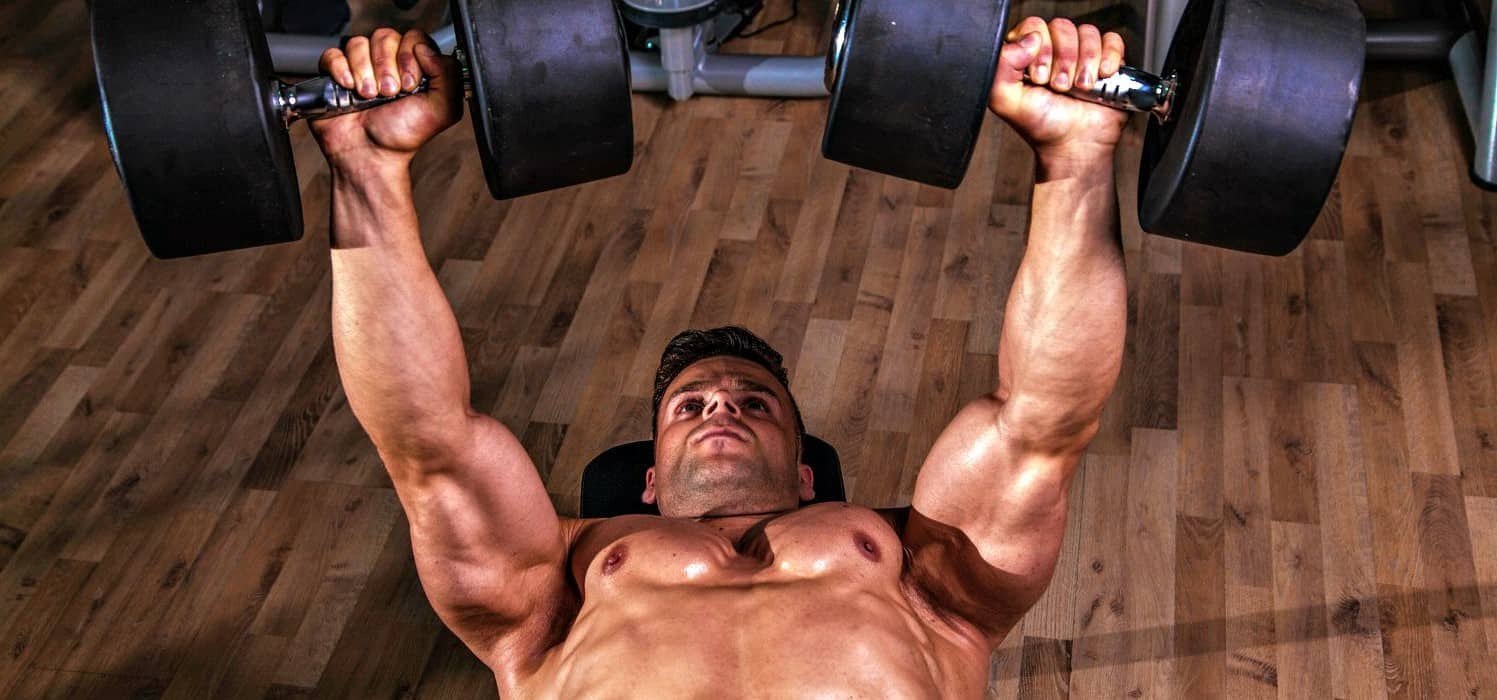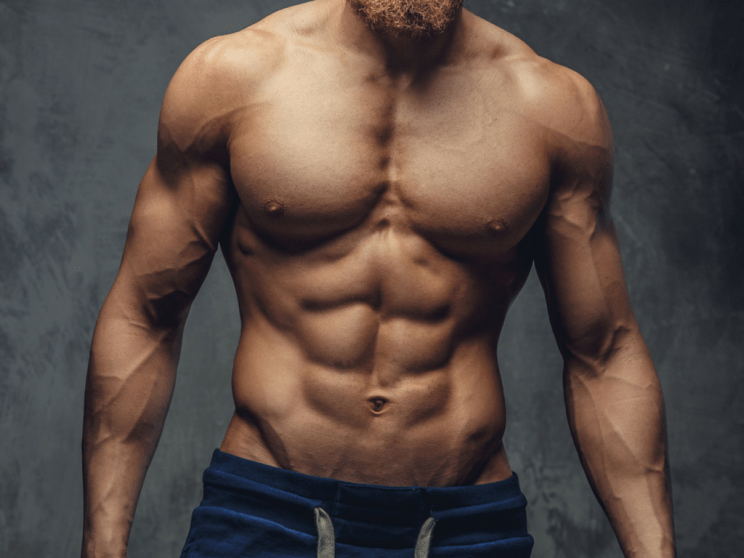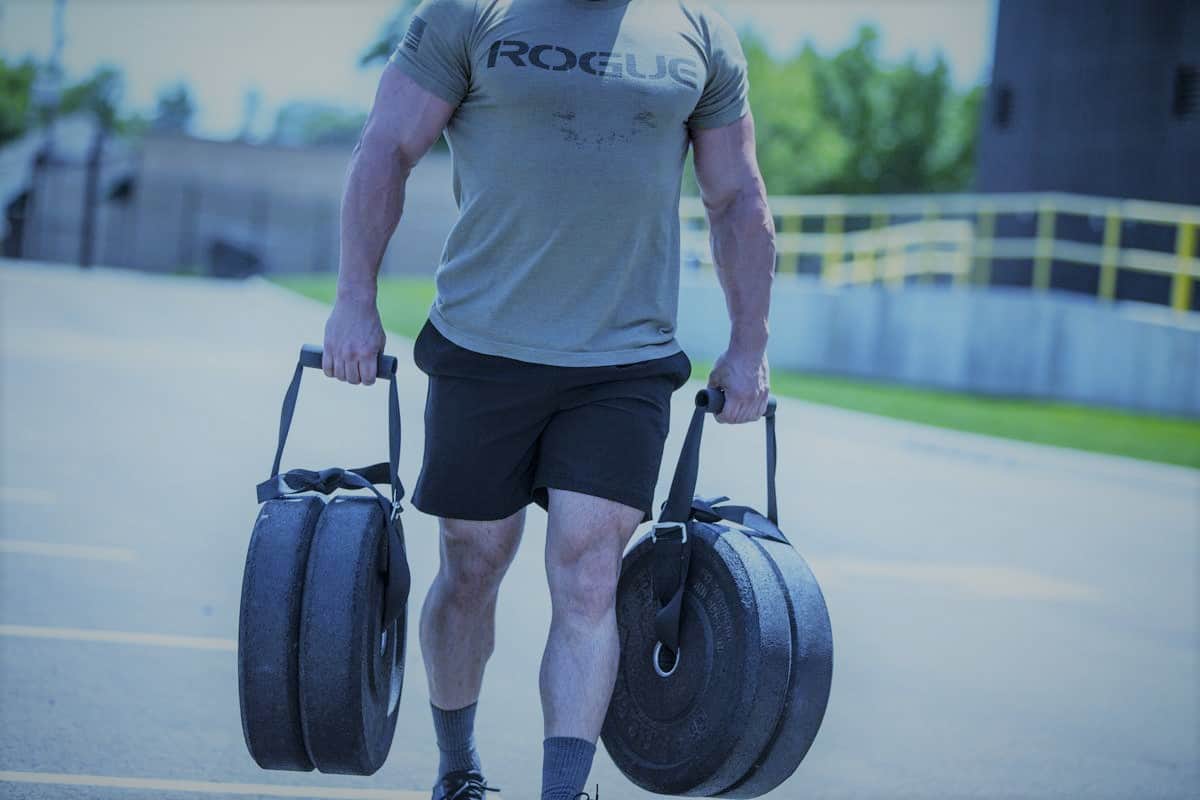Powerlifting is a sport that relies on a 20kg barbell, at least 2.20m in length, with a diameter of 28-29mm. Some federations use longer and/or thinner bars, but barbells are central to the sport, as they are in weightlifting. As such, you cannot do powerlifting with dumbbells.
You cannot compete in powerlifting with dumbbells. But you can use them to supplement your training, address asymmetries in your strength and muscular development, and target weaknesses. Dumbbells are by no means foreign to a powerlifter, and if you’re serious about picking this sport up, you’ll use dumbbells in your powerlifting training.
If all you’ve got at home right now are adjustable
dumbbells (or a wide range of different dumbbells), then there’s plenty of options
for you to continue to work on your press, squat, and even your deadlift.
Nothing beats a barbell (remember specificity, folks), but it’s better than
nothing.
Dumbbells for Accessory Training
Each of the big three can be performed with dumbbells. Arguably the most awkward of these will be the squat. The easiest of these is the deadlift. Depending on your strength and the weight of your dumbbells, you can also easily bench press or floor press to simulate powerlifting with dumbbells. For the squat, your options are to rest the dumbbells on your traps (behind/beside the neck) or to pick up just one and go for goblet squats.
Beyond that, there are many, many other
exercises for you to try as accessory work to your main lifts. Dumbbells are incredibly
versatile and the fact that they’re easier to wield with one arm than a barbell
means you can load weight asymmetrically, address weak points, and train
unilaterally.
The rule of specificity is that the best way to train the squat, bench press, and deadlift, is to squat, bench press, and deadlift. Powerlifting with dumbbells just isn’t powerlifting anymore, but you can still get a good strength or hypertrophy workout in depending on the weight of the dumbbells you’ve got access to. Let’s go over a couple of select exercises for the press, the squat, and the deadlift that you should give a try, as well as a couple of great non-powerlifting exercises for hypertrophy and core gains.
Dumbbell Pressing Exercises
Like a barbell, dumbbells can be used on a
flat, incline, or decline bench for a variety of horizontal pressing exercises.
The fact that they can move independently of each other can help lifters work through
shoulder or elbow problems by trying out a variety of grips while pressing. Try
rotating your forearms in different ways throughout the press to find the most
comfortable angle.
The same rules apply as when pressing a barbell
– shoulder blades retracted and depressed, with leg drive pressing them down
into the bench. A minor arch can help you translate the leg drive into the
upper back properly. You can also vary your grip to target the chest or triceps
more or go supinated for greater shoulder relief (give this a try with a lighter
weight and get used to it).
Overhead presses are much the same way. Many people prefer dumbbell presses to overhead presses because they are far less restrictive and allow each arm to follow along a natural movement path to complete the lift. They’re a great alternative if your overhead pressing mechanics are already properly trained and efficient. This means you can keep an active core and back, extend your upper back properly (good thoracic flexion), keep your glutes tight, and extend your arms properly (locking out in line with your spine, with your head “through the window”, and your forearms remaining perpendicular with the floor throughout the movement). Overhead pressing isn’t a powerlifting movement, so there’s no harm in using dumbbells for it.
Use a mirror to take note of how you press,
and which pressing variation you find most comfortable. Experiment with a closer
angle (with your elbow tracking closer to the midline of the body) and a wider
angle (with the elbow and weight starting further away from the body). A
history of shoulder problems or injuries might make overhead pressing with a
barbell somewhat uncomfortable, but dumbbells can make it more tolerable by
giving you a better “dumbbell path”.
You can load unilaterally when pressing – doing horizontal presses with a heavy weight is a decent way to get your core involved as well, while single-arm overhead presses let you involve your torso a little more and overload each arm individually, almost like a push press but arguably a lot safer than doing it with two really heavy dumbbells (because of the coordination that might require, and the fact that most people can’t safely dump their equipment in a limited space at home). Heavy single-arm overhead presses are also just really fun, in my opinion. You can do them strictly (no leg drive) but incorporate the torso into completing the movement, leaning a bit to finish the lift.
Dumbbell Squatting Exercises
The squat is an exercise that can be completed
in many different ways, but where dumbbells really shine is in unilateral
squatting exercises. The split squat is probably my favorite accessory for powerlifting
with dumbbells, although it can be performed just as well with no weight, or
with bands, or a barbell.
Unlike a lunge or a single-legged (pistol)
squat, the split squat has the back leg resting on a higher surface, and the
goal is usually to stretch into the bottom of the squat, so the back knee
touches the floor. It provides both a great quad stretch and is a good way to
train the legs unilaterally, while being a useful quad/squatting accessory, as
a finisher.
Walking lunges with dumbbells are also a
fun way to finish a squat session or add a little extra spice to your leg
hypertrophy day, especially if you’re combining the deep stretch at the bottom
of each rep with a heavy lean over the front leg (knees well over the toes) so
you really fight to get out of the hole and mostly utilize the front leg’s quad
to get you back up.
If you’ve got limited ankle mobility, a dumbbell acts as a perfect counterbalance weight to help you do single-leg squats by giving you something to keep you leaning forward. It does make the pistol squat harder. Alternatively, buy some squat shoes or fix your mobility.
Good old bodyweight squats can be made
harder with dumbbells, either with one loaded in front of you, or two loaded on
your back. If you’ve relatively strong and only have a limited selection of
dumbbells, you’re probably better off with unilateral exercises to up the
resistance.
Dumbbell Pulling Exercises
You’d think you can only really do horizontal pulls with a dumbbell, and you’d be mostly right. Mostly. If you’ve got a pull-up bar, you can do the traditional thing of clenching the dumbbell between your calves or feet to do loaded pull-ups, or you can stuff a dumbbell or two into a bag and wear it to make the lift harder. Take care to pick a bag with a pretty solid construction, because most bags aren’t designed to be used to move around heavy compact objects like a 10+kg dumbbell. By the way, don’t wear the bag around your back. Keep it in front of you.
Alternatively, you can of course use
dumbbells for single-arm and normal bent over rows. Different angles and tips
can help you target your back differently. Keeping the back more upright helps
you target the upper back more, especially the rhomboids. Flare your elbows and
squeeze your shoulder blades together.
If you want to target the lats more, keep
your torso more in line with the floor and pull the weight a little closer to yourself,
so your elbows are a bit closer to the midline. Regardless of whether you’re
pulling with one or two dumbbells, always be sure to bring your elbows behind
your back – that’s how you contract the lats. If you’re pulling with one arm, take
care not to rotate your trunk or shoulders.
You can lie on a bench to further isolate
the upper back and lats, without straining or tiring the lower back (the spinal
erectors). You don’t have to do this.
Dumbbell Hip Hinge Exercises
If you’ve never deadlifted before, then deadlifting dumbbells won’t necessarily help you figure out the mechanics of the deadlift. One of the hardest parts of the deadlift is the fact that the barbell is loaded in front of you, and limits how far your knees can travel over the bar and toes, thus limiting the use of the quads in the early stages of the lift (save for the first few inches immediately off the floor). Learning to properly wedge and brace with the barbell is also critical for beginners, so don’t expect much carry over from deadlifting dumbbells, especially because you’ll be hard-pressed to find dumbbells heavy enough to effectively train the movement.
Instead, use dumbbells to train movement
patterns that are similar and/or secondary to the deadlift, and help build
stronger glutes, hamstrings, and erectors. My go-to is the single-leg hip
hinge, which is basically a one-legged Romanian deadlift. Minimal knee bend (a
little is mandatory, don’t keep your leg locked out), hips and shoulders
squared and not twisting, weight loaded in front of you, and a slow eccentric
and concentric motion. Squeeze the glutes and hammies on lockout, and repeat.
You won’t really feel these at first, but they’re pretty tough, and if you’re
loading them with pretty heavy dumbbells and going for reps, you’ll definitely
feel them the next morning.
Regular Romanian deadlifts can also be
challenging depending on your strength level, and these can be performed with
dumbbells. Differences between a Romanian deadlift and a regular deadlift
include the bar path (it’s typically a little further away from you), the use
of your quads (you should keep your knees minimally bent throughout the movement),
and the time under tension (Romanian deadlifts are performed without resetting
every rep, and without a bounce – just keep holding the weight throughout the
set).
If you’re keeping the weight on your shoulders/back like you might do in a dumbbell back squat, you can also use your dumbbells to perform a good morning. Good mornings work the glutes and erectors and are performed by sitting back into your hips until your back hits parallel while keeping your knees minimally bent. Think of the worst possible quarter squat you’ve ever seen someone perform, but minus the spinal flexion. That’s a good morning. Not only are they pretty great for warming up before squats, and not only are they good accessories for deadlifts (especially with a safety squat bar, so you don’t have to bother with good shoulder mobility), but good mornings are especially useful when you don’t have access to something like a glute-ham raise or a good way to do hyperextensions, and just want to load your erectors.
Dumbbell Shoulder Exercises
Dumbbells are a powerlifting fanatic’s best friend for solid shoulder isolation and development. I’ve already talked about why it’s important to power build those shoulders, and I stand by everything I said in that post. The shoulders are an important part of the bench-pressing equation, and strong rear delts also indirectly contribute to keeping your upper back nice and stiff throughout the deadlift (mind you that’s a very indirect contribution). The biggest benefit of rear delt isolation, however, is improved shoulder health. We press a lot, so we need to pull a lot to keep things developing equally and avoid injury. I use dumbbells in powerlifting most often for shoulder isolation.
You’d think vanity was the main reason us powerlifters use dumbbells for lateral raises with a side of intensely staring into our own reflection, but building stronger shoulders can help you reduce the frequency of your bench injuries (observing better bench pressing form is a prerequisite here, of course) and avoiding the anterior shoulder tilt that comes from pressing a lot without working the rear delts and upper back properly.
Aside from the pressing exercises I’ve already mentioned, for which the anterior delts are a major mover, lateral raises are an obvious choice for training your medial deltoid. Bent over rear delt flies and chest-supported rear delt flies (performed by lying on a bench) help isolate the rear delts. They’re a great use of dumbbells in powerlifting.
Don’t use dumbbells to practice shoulder rotation exercises. Do these with bands or cable machines. Dumbbells utilize the nature of gravity to provide resistance that only goes one way – towards the center of the Earth. I recommend that you use a light resistance band to do pull-aparts, face pulls, and external shoulder rotation to warm up or train the muscles supporting the delicate and complex ball-and-socket construction of the human shoulder.
Tris, Bis, Hams, and Calves
Dumbbells are great for not just a bunch of
accessories to your main lifts and plenty of shoulder work, but they’re also
great for hammering the glamour muscles + the hamstring (yes, the hamstring). I’ve
mentioned hip hinges, but you can actually use your feet and a decline bench to
hold a dumbbell and do ham curls. Give them a try, they’re pretty fun this way.
No reason not to use a ham curl machine if you’ve got access to the gym, but
they’re an alternative ham curl at home provided you have a flat declining
surface.
Curls, tricep extensions, and a large variety of tricep accessories (I recommend John Meadows’ extensive library of presses and tricep isolation movements) are natural answers here, but I heavily recommend using dumbbells to perform hammer curls, concentration curls, or preacher curls at least twice a week, ideally on days when you’re pressing a lot. Supinated and neutral grip curls can help avoid elbow tendonitis by training the brachialis and bicep for better stabilization during the press and to make sure you have the mobility and strength to properly supinate your forearms. Barbells are even better here since they force you to stress the supination.
If you don’t have access to any machines,
dumbbells might be your best bet for developing the calves. Powerlifters generally
don’t have a good reason to train the calves. They don’t exactly have any
carryover to the big three lifts, because each one requires the feet to remain
firmly planted in the ground and do not require you to forcefully extend as you
might when cleaning weight off the floor (the Olympic kind of cleaning).
Nevertheless, if you’re conscious about
your calves or if you feel that they’re actually causing you problems (lack of
balance in the squat, or something), then you can use dumbbells and a step to
do single-leg calf raises and really isolate those suckers. You can also grab a
chair opposite to a step, get your feet on the step, and rest the dumbbells on
your knees to simulate seated calf raises. While standing calf raises
prioritize the gastrocnemius (the short, thick muscle that attaches to the thigh
bone), seated calf raises stress the soleus (the longer muscle that attaches to
the head of the shin bone).
Dumbbells to Train the Squat
I mentioned goblet squats earlier in this little guide, and I’ll give them a separate entry down here because they’re great for beginners. People generally have a much easier time loading their squats in front of them than on their back, and if you’ve ever seen someone struggle to squat properly with a barbell on their shoulders, typically giving them a dumbbell and a couple of cues helps them start to properly get the hang of healthy squat mechanics. This is because we’re generally used to loading weight in front of us, save for backpacks. People typically (not always) get the hang of deadlifts fairly quickly but struggle with squats for a while. This is a great use for dumbbells in powerlifting.
Once someone begins to get the hang of the
goblet squat with a fairly heavy weight, they can transition to the front squat
while going through a few exercises to address any weaknesses their coach (or
you) might have found, including common ones like tight quads/overactive hip
flexors and weak glutes. Improving glute strength while stretching and rolling flexors
like the iliopsoas will often help someone get deeper into their squat, avoid
knee valgus, and begin to prepare themselves for the next few challenges, like
bracing properly under a load (goblet squats help with this as well).
Dumbbells are great, and even the strongest
powerlifters will use them for important accessories, from rear delt prehab to moderate
weight split squats and lunges. While you shouldn’t rely on dumbbells for
powerlifting purposes, they’re great for crafting a number of useful accessory
exercises.




